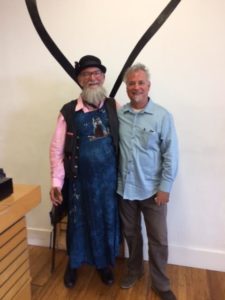Today SevenPonds speaks with Dress Wedding, a Holistic Services Director with Harborside Health Center in Oakland, California. Also joining Dress is Kelly Quirke, Community Engagement Coordinator. This is the second part of a two-part interview with Harborside, a state-of-the-art medical marijuana dispensary that provides service to patients in Oakland and San Jose, California. Today Dress and Kelly offer me a walking tour of the surprisingly large dispensary, while we discuss how medical marijuana can be used at end of life.
Note: This interview has been edited for length and clarity.
 Suzette Sherman: Hospice workers and oncologists are now learning how medical marijuana can be used at end of life. Tell me about the different types of marijuana and their application?
Suzette Sherman: Hospice workers and oncologists are now learning how medical marijuana can be used at end of life. Tell me about the different types of marijuana and their application?
Dress Wedding: The plants we produce are indica, sativa or hybrids. There’s a wide variety of plants, and it’s important to know their effects. Generally, indica is more relaxing and can help you sleep, while sativa is more activating. The hybrids provide many possibile combinations of these effects. There are 400 compounds in cannabis. That’s why custom prescriptions are the future of medical marijuana.
Kelly Quirke: Our bodies produce cannabinoids that help ensure homeostasis. Micro dosing can help balance you.
Suzette: Interesting. Now that medical marijuana can be used at end of life here in California, are any hospitals on board with it?
Dress: Yes. What’s typical is a medical system will let each doctor make their own decisions as to when and how much they choose to recommend marijuana. As you mentioned, we see it used in hospice as well as oncology.
Kelly: There is a problem with the perception of cannabis. We have had marijuana prohibition for 80 years now. Currently 29 states have some sort of cannabis or CBD legalization. Alabama is one of them — Hi, Jeff Sessions!
CBD is a cannabis compound that does not make a patient “stoned” and counteracts the psychoactivity of THC. The issue of children with seizures has pushed more cannabis acceptance. We now see clinical trials here and there. The stigma is breaking down somewhat rapidly. Yet it is still here, especially with Trump talking about more enforcement. We see it becoming more accepted, but progress is slow.
Suzette: What about studies of cannabis use?
Kelly: There are not enough studies to date. And that is how physicians operate — by referring to studies for data and proof. We see seizure disorders, then cancers that are getting some relief or being stopped cold with cannabis. It’s a range.
The challenge we still have is cannabis has Schedule 1 status (drugs, substances, or chemicals that the Drug Enforcement Agency says have no currently accepted medical use) so no one is getting involved. Plus there’s no tax write-offs, only tax penalties.
Italy, South Africa, and Canada are studying cannabis more. We had a group approach us about using our patients for a proof of concept pain management and insomnia study. There is so much empirical evidence, but to go into the cancer world there needs to be research in place.
Suzette: What do you see in the future?
Kelly: We see more acceptance with lots of room for improvement. The medical profession is used to holding very rigid standards. It’s a big challenge to move them in a new direction.
Suzette: It is known that those at end of life get depression and anxiety about dying. I gave my dad some edibles with a specific dose noted. Yet even that dose was too strong for him. I find dosing is a big issue. And the difference between edibles and smoking is dramatic.
(Both Kelly and Dress laugh) Dress: Who has not had one of those experiences? True, the elderly are not familiar with cannabis.
Kelly: We are further than we have been, but we still have a long way to go. We have patients who are six months old. There are so many considerations: What are you suffering from? What’s your age? It’s all moving towards making custom mixes – we are headed towards super-specific compounds. There are billions lined up to go into the research. It will revolutionize cannabis.
Dress: Ever since Colorado and Washington legalized cannabis, edibles are now labeled with how many milligrams are in the compound. One reason is that all of a sudden the media became interested, especially when kids started overdosing on cannabis gummy bears. We demand this labeling from our suppliers too. The label will tell you how much is in the whole package and you can divide it up to manage your dosing better. Our suppliers have gotten a lot better at it.
Kelly: People do need to be careful with what they take. Like popcorn and nuts, it’s easy to eat them without realizing how much you’ve eaten. There are many types of edibles like cookies, honey, and chocolates. There are also different methods of administration, like patches and suppositories. But even with a standard dose, the effect will depend on the individual patient.
Suzette: What about morphine versus medical marijuana at end of life? With morphine, patients often need a higher dose as time goes on. Sometimes this makes it hard for the person to get up and function. Assuming their fatal condition allows them to use cannabis, how would it help?
Kelly: Cannabis will amplify the action of opioids.
Suzette: Oh wow, that could mean less morphine! And maybe that would allow someone at the end of life to be able to function longer before they die.
Kelly: In the states that have passed laws legalizing medical marijuana, cannabis hasn’t been a “gateway to opioid addiction.” In fact, opioid addiction has dropped 25 percent in those states.
Suzette: As someone said to me, the Boomers are a generation that used recreational drugs, so of course they will bring drugs into their end of life experience.
Dress: Yes, and a lot of seniors like their cannabis delivered. Rossmore Retirement Community here in the Bay Area has 300 members now. We have focused on educating seniors, a lot of whom aren’t not happy with the pharmaceuticals their doctors offer them.
Suzette: I see we are at the beginning of really understanding the possibilities of cannabis at end of life. Thanks so much for the tour, your dispensary looks fabulous! It was great speaking with both of you!
Kelly: Yes!
Dress: You too!
Did you miss the first part of Dress and Kelly’s interview? If so, please catch up here.

 How Can Medical Marijuana Be Used at End of Life?
How Can Medical Marijuana Be Used at End of Life?




 National Donate Life Month Reminds Us To Give
National Donate Life Month Reminds Us To Give
 How Dare You Die Now!
How Dare You Die Now!
 Debating Medical Aid in Dying
Debating Medical Aid in Dying














